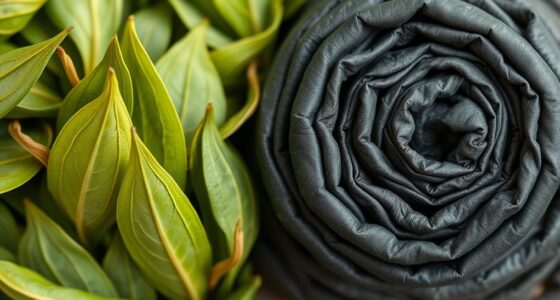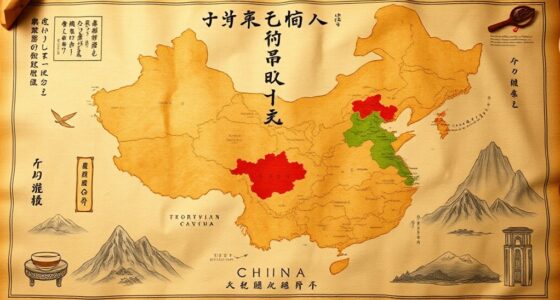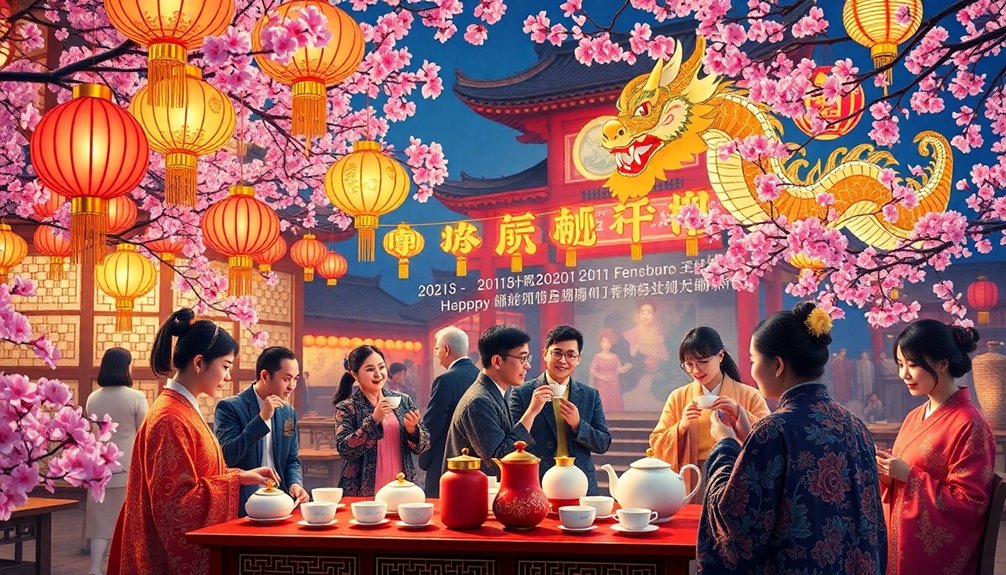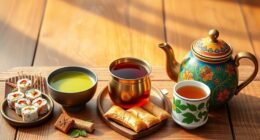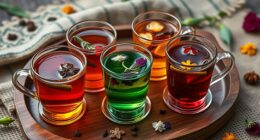When you explore the ancient art of Chinese tea brewing, you're stepping into a world rich in tradition and culture. The Gongfu tea ceremony showcases skillful preparation, where water quality and leaf-to-water ratios matter. Each type of tea, whether oolong or green, requires specific brewing techniques to bring out its unique flavors. This practice fosters connections, mindfulness, and hospitality among communities. You'll discover how regional preferences shape tea choices and deepen your appreciation for this intricate art form. There's much more to uncover about balancing flavors and rituals that enhance your tea experience, so keep going!
Key Takeaways
- The Gongfu tea ceremony showcases skillful preparation, emphasizing a high leaf-to-water ratio and short infusion times to enhance flavor.
- Quality water, especially Hill Water, is crucial for elevating the taste of Chinese teas during brewing.
- Six main types of Chinese tea, including oolong, require specific brewing techniques to fully appreciate their unique flavors and health benefits.
- Regional variations in brewing methods reflect local preferences and water sources, enriching the overall tea experience across China.
- Cultural significance of tea is deeply rooted in tradition, symbolizing harmony, refinement, and community connections within Chinese society.
Introduction

Tea is more than just a beverage; it's an ancient art form deeply rooted in Chinese culture. When you dive into the world of Chinese tea brewing, you'll discover the intricate techniques and rituals that elevate this simple drink into a refined experience.
At the heart of this art is the Gongfu tea ceremony, which emphasizes skillful preparation and a genuine appreciation for the nuances of tea.
One key aspect you must consider is the quality of water. Hill Water is often preferred for its purity and ability to enhance the tea's flavors.
The brewing process involves a high leaf-to-water ratio and short infusion times, allowing you to extract the complex flavors that lie within each type of tea.
As you explore the six main types of Chinese tea—Green, Yellow, Black, White, Light Green, and Red—you'll learn that each requires specific brewing techniques and optimal temperatures.
Delicate teas thrive at lower temperatures, while robust varieties flourish at higher ones.
With the right tea wares, like a Zisha tea pot and bamboo tea spoon, you'll truly appreciate the artistry behind every cup.
Cultural Significance of Tea

Throughout history, Chinese tea has woven itself into the fabric of society, evolving from a medicinal drink to a symbol of cultural identity. Initially valued for its health benefits, tea became a staple during the Tang dynasty, when its popularity peaked. The first known tea book, "The Classic of Tea," authored by Lu Yu, laid the foundation for the elaborate culture surrounding tea, establishing its significance in both daily life and philosophy.
As you explore the cultural significance of tea, you'll find that it transcends mere consumption; it embodies values like harmony, refinement, and a deep appreciation for nature. The tea ceremony, especially the Gongfu style, showcases the meticulous preparation and mindfulness that elevate tea drinking to an art form. This ceremony not only highlights the skill involved but also reinforces social connections, inviting participants to engage in meaningful interactions.
Over centuries, tea has fostered a sense of community, allowing you to share in traditions that celebrate personal and collective identities. In essence, tea is much more than a beverage; it's a cherished cultural treasure that continues to bond people across generations.
Tea's Role in Chinese Society

In Chinese society, the presence of tea extends far beyond simple enjoyment; it serves as a vital thread that connects people across various aspects of life. Initially used as a medicinal beverage, Chinese tea evolved during the Tang Dynasty into a cultural staple, reflecting its significant role in daily rituals and social gatherings. Oolong tea, in particular, is celebrated for its unique flavor profile and health benefits, which have made it a popular choice among tea enthusiasts. Additionally, the significance of traditional healing practices in cultures worldwide parallels the reverence for tea in Chinese society. The ritual of tea brewing also contributes to emotional resilience, as the process can provide a calming effect and serve as a meditative practice.
The writings of tea master Lu Yu, especially in "The Classic of Tea," elevated tea brewing to a sophisticated art form, influencing how tea is perceived and appreciated.
Tea drinking has become an important social ritual, where hospitality and etiquette take center stage. When you prepare and serve tea, you engage in a mindful practice that fosters connection among friends and family. The Gongfu tea ceremony highlights this artistry, emphasizing skill in preparation and the shared experience among participants.
Throughout history, tea has played a central role in customs and traditions, symbolizing harmony and community. Whether it's during a religious ceremony or a casual meeting, the act of brewing and sharing tea brings people together, reinforcing social bonds and creating a sense of belonging in the fabric of Chinese society. Additionally, various types of flower teas, such as Hibiscus tea, are often incorporated into these gatherings for their vibrant flavors and health benefits.
Regional Variations in Brewing

Regional variations in brewing methods across China showcase the country's rich tea culture and diverse preferences.
In the southern provinces like Guangdong and Fujian, you'll find the Gongfu tea ceremony, which emphasizes skillful, short infusions that enhance the flavors of high-quality oolong tea leaves. Here, specialized tools such as gaiwans and fairness cups are essential.
In contrast, northern regions often adopt a more Western-style approach, using larger teapots and longer steeping times. This method can lead to a more astringent taste profile, which some tea drinkers prefer.
The local water sources play a crucial role, too; different types of water—hill, river, or well—are chosen based on their quality, profoundly impacting the final brew.
Your choice of tea also reflects regional preferences. While oolong tea is celebrated in the south for its complexity and depth, green and black teas dominate the north, leading to distinct brewing styles.
Understanding these regional nuances enriches your tea experience, allowing you to appreciate the intricate tapestry of China's tea traditions.
Cultural Appropriation in Tea Practices

Cultural appropriation in tea practices raises important questions about respect and understanding in the appreciation of traditional customs. When elements of ancient Chinese tea culture, like the Gongfu tea ceremony or traditional tea wares, are adopted without acknowledgment, it can lead to a misunderstanding of their historical significance.
This commercialization often strips these practices of their true meaning, reducing them to mere trends rather than honoring their rich origins.
As a tea enthusiast, you should strive to engage with these traditions mindfully. Recognizing the deep cultural roots of tea, as highlighted by scholars such as Lu Yu, is essential for appreciating the best cup.
Engaging in open dialogue about cultural appropriation encourages a respectful approach to tea practices, fostering a deeper connection to the communities that have nurtured these customs for centuries.
Practical Applications

When you dive into the art of Gongfu tea brewing, you'll discover that practical applications can elevate your tea experience significantly. This method emphasizes skillful brewing techniques, using a high leaf-to-water ratio for richer flavors.
For black tea, you'll want to use about 6 grams of leaves in a 3-ounce gaiwan filled with boiling water. Steep for just 20-30 seconds, allowing you to savor multiple infusions that reveal the tea's complexity.
Water quality plays a crucial role in this process. The essence of water matters; opt for Hill Water or River Water, and if you must use tap water, aerate or boil it first to enhance its quality.
Different teas require specific temperatures: delicate varieties need lower temperatures (70-80°C), while robust black teas perform best at the boiling point (90-100°C).
To fully enjoy this experience, equip yourself with essential tools like a gaiwan, fairness cups, bamboo tongs, and porcelain cups. These items help you appreciate the subtleties of each infusion, transforming your tea session into an artful ritual.
Embrace these practical applications and watch your tea brewing skills flourish.
Conclusion
In exploring the ancient art of Chinese tea brewing, you've uncovered a rich tapestry of culture and tradition. You've seen how tea serves not just as a beverage, but as a vital part of social life and identity. By appreciating regional variations and being mindful of cultural appropriation, you can enjoy tea in a way that honors its heritage. So, whether you're brewing a cup for yourself or sharing it with friends, you're part of a timeless practice.




